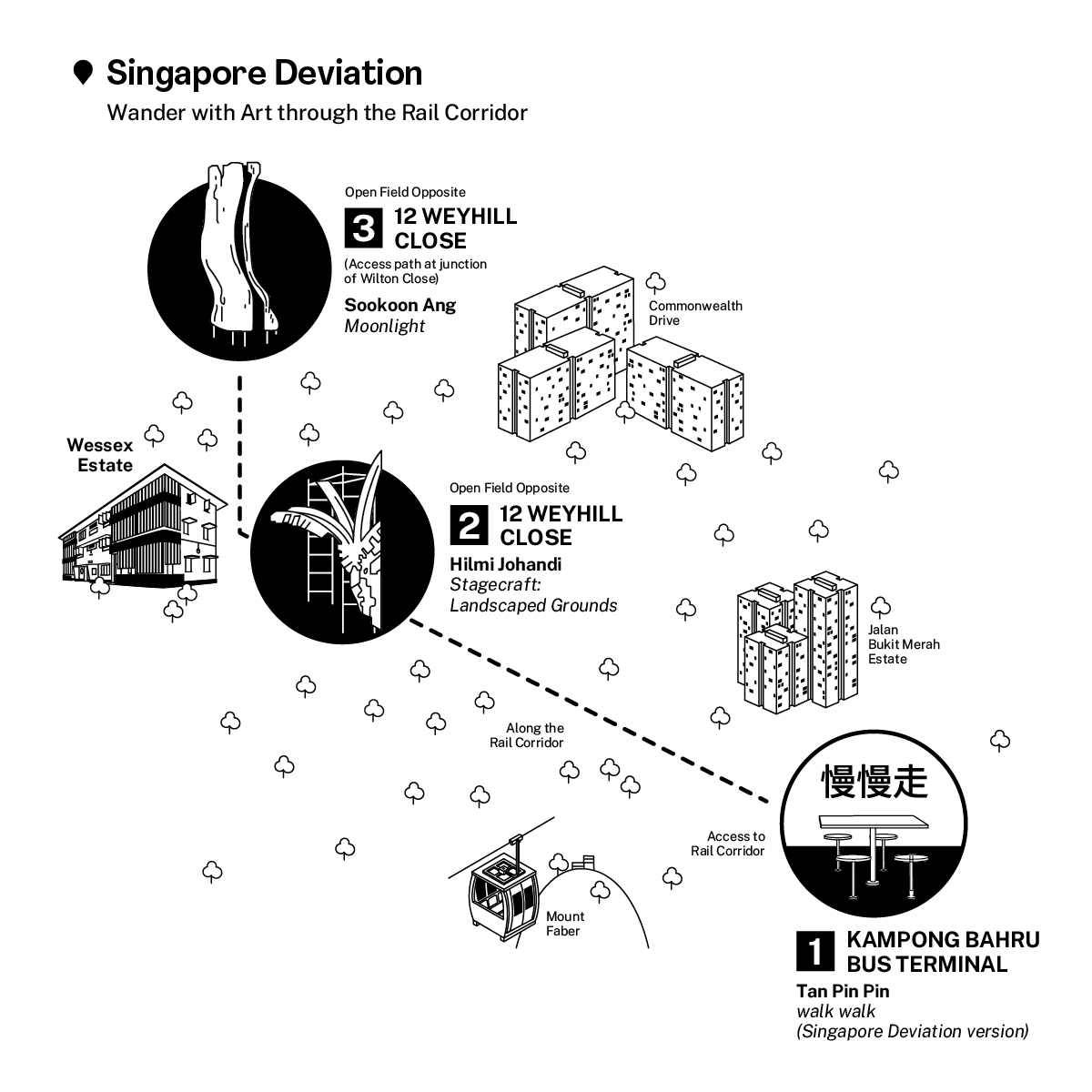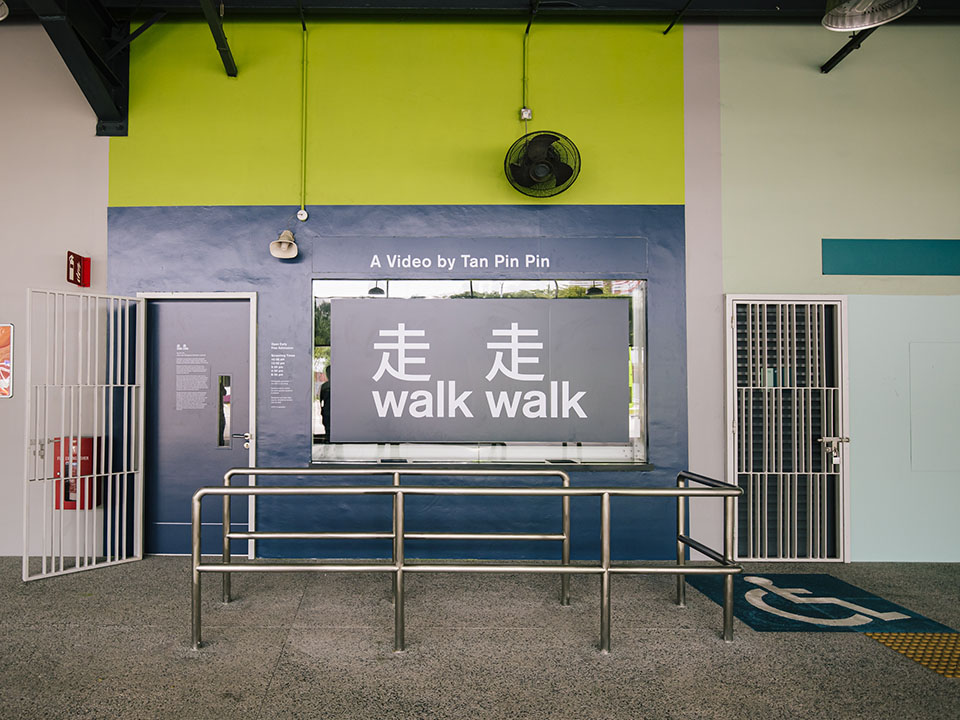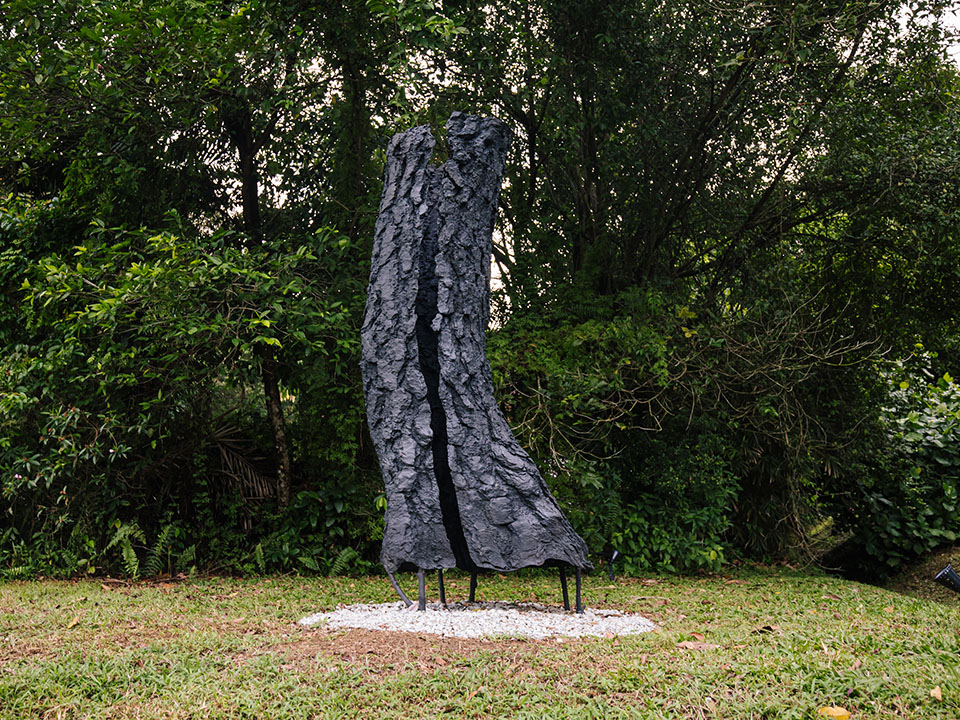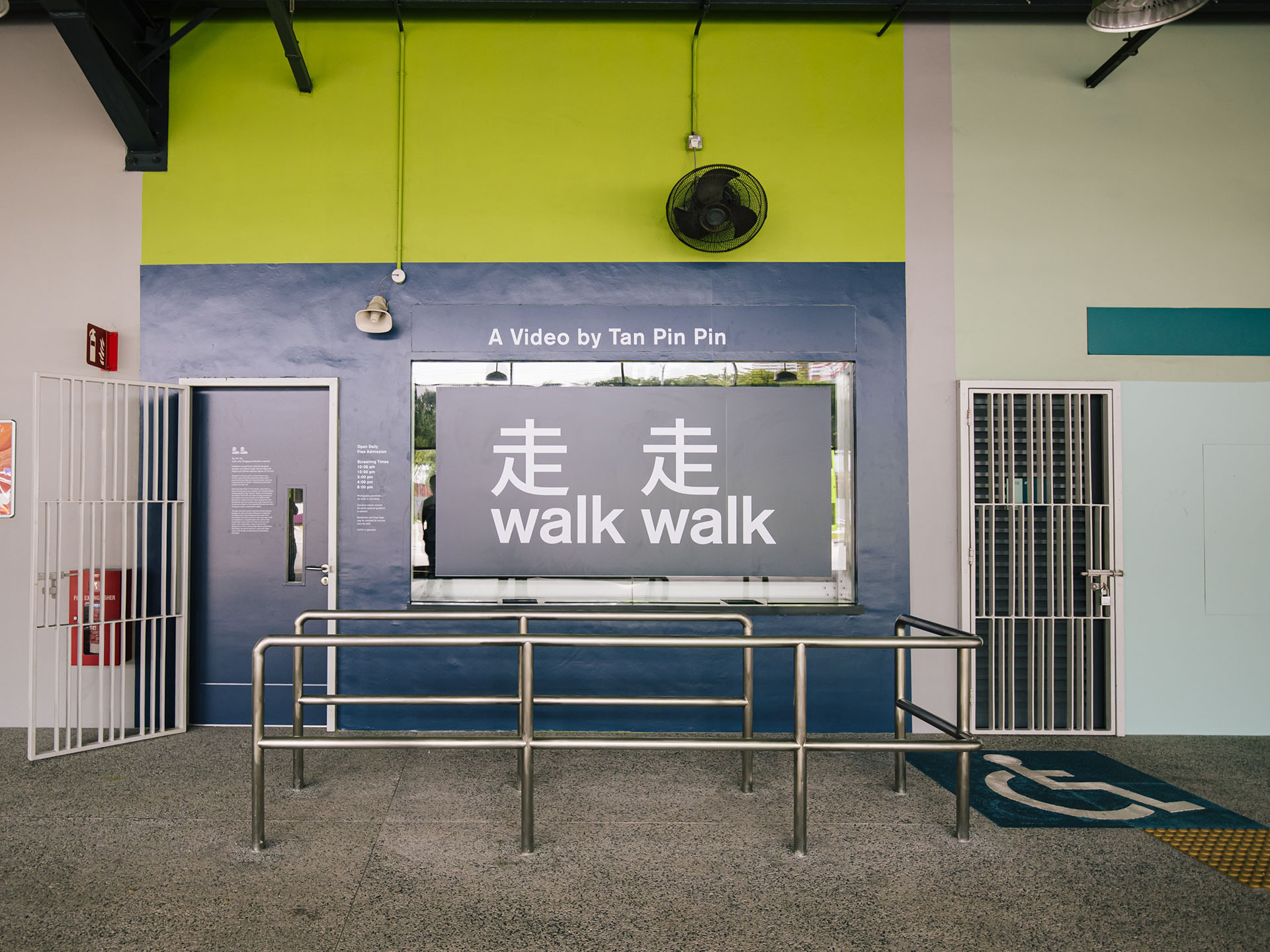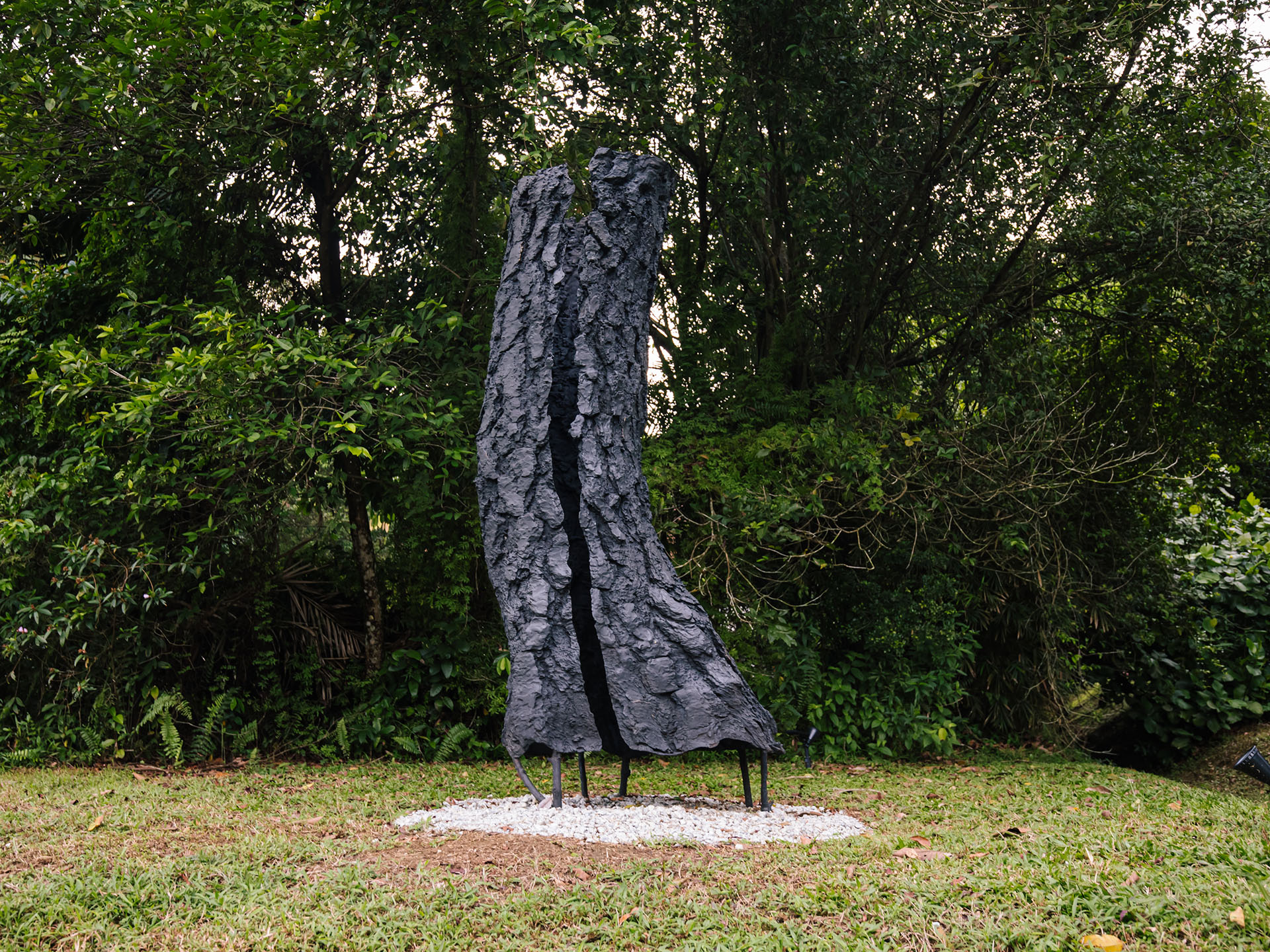Public outdoor work
Various locations along the Rail Corridor (Wessex Estate and Kampong Bahru Bus Terminal)
Singapore Deviation:
Wander with Art Through the Rail Corridor
Experience nature enlivened through art as you go off the beaten track of the iconic Singapore Rail Corridor.
Singapore Deviation is a series of public art commissions exploring the iconic Rail Corridor in Singapore through the works of three artists: Sookoon Ang, Hilmi Johandi, and Tan Pin Pin. Conceived as site-specific installations, each artist offers a unique entry point into the evolving uses of the site, from colonial railway to wildlife corridor and recreational trail.
The public art trail is named after a revised alignment to the original Singapore-Kranji Railway in 1932, which resulted in the present-day 24km track that runs through the north-south axis of Singapore.1 Through its conveyance of passengers and goods between Singapore and Peninsular Malaysia, the railway passage embodies histories that are integral to the city-state’s transformation. It remained a significant means of transportation and communications and operated for decades before the last train from Tanjong Pagar departed in 2011. Since then, it has been repurposed as an urban retreat and community leisure zone.
Singapore Deviation calls attention to the shifting publics and uses of the Rail Corridor. The series sets up an encounter with a range of figures, messages and sensations that constitute the multi-faceted experience of the Rail Corridor. Each artist reanimates the physical site, considering the Rail Corridor not just as a space of transit but as a constantly changing space, with an ambiguous status and uncertain future. These works invite new perspectives on the diverse social, historical, and ecological relationships that determine the continued relevance of this historic railway track.
Singapore Deviation is commissioned by The Everyday Museum, a public art initiative of Singapore Art Museum. It is made possible with the generous support of Sun Venture and in venue partnership with JTC, SBS Transit and Land Transport Authority.
To find out more about the programmes and discover #ArtWhereYouAre, please visit

1 Curator’s note: At the end of the 1920s, a nine mile “deviation” to the original Singapore-Kranji Railway was proposed, partly motivated by the need to elevate and realign certain portions of the track that were prone to frequent flooding. When the realignment was completed in 1932, it brought trains through a new route from the Bukit Timah station to Tanglin Halt and Kampong Bahru, finally arriving at the new terminus at Tanjong Pagar. For more details: https://biblioasia.nlb.gov.sg/vol-7/issue-3/oct-dec-2011/singapore-railway-lines
artwork highlight
related events
check out the line-up of free and ticketed events below!
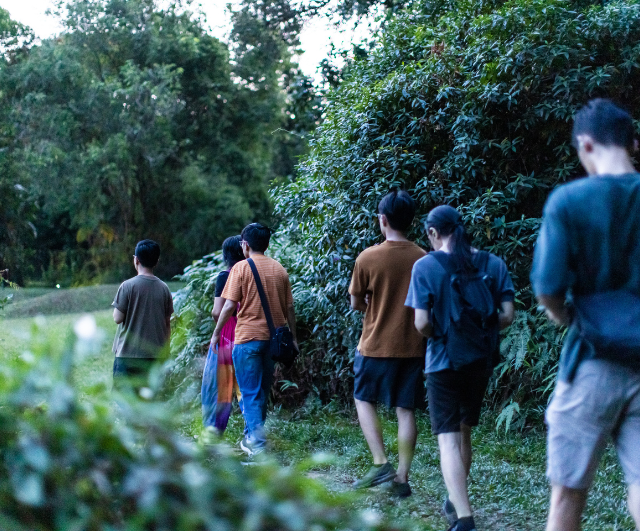 |
Public Art Tour: Singapore Deviation
The Everyday Museum’s monthly public art tour along the iconic Rail Corridor is back with a refreshed programme! Embark on an art-inspired journey every third Saturday of the month (except for 20 September 2025) and let SAM’s public art team take you on a unique exploration of the Rail Corridor's transformation from colonial railway to wildlife corridor and recreational trail through the works of three artists: Sookoon Ang, Hilmi Johandi and Tan Pin Pin.
This guided tour is suitable for ages 16 and above. This tour will end at Kampong Bahru Bus Terminal.
Special thanks to Zai Tang and Elliott Ong for their valuable insight that contributed to the content of the programme.
|
2023
Screening room, Single-channel video with English and Chinese subtitles, 27 min 13sec; vinyl texts, various dimensions and LED backlit sign, 45 x 150 cm
Location: Kampong Bahru Bus Terminal
--------------------
Inspired by a commonplace activity along the Rail Corridor, walk walk (Singapore Deviation version) is a video and an installation on the theme of walking. While mundane, walking is a carefully managed practice in Singapore, shaped by public agencies and private developers. The island-nation is designed to be very walkable, with air-conditioned shopping malls and wellmaintained sidewalks shaded by trees. Siting this work in a bus terminal, artist Tan Pin Pin highlights ideas about freedom of movement, how walking is a basic expression of this freedom, and how public transportation further supports our mobility.
walk walk (Singapore Deviation version) comprises a video and text installations. The video documentary installed at the terminal’s Transitlink Office features several individuals discussing the role of walking in their lives. On the ceiling beams above the bus berths, lines of text reveal a poem about walking as commuters pass through the terminal. Read together, the lines create an onomatopoeic effect, mimicking the rhythmic movement of steps.
In the nearby National Transport Workers Union (NTWU) Cafeteria frequented by bus captains between trips, an LED text installation of the common parting phrase, “慢慢走” (walk slowly) imparts well wishes to the bus captains as they embark on their daily journeys.
About the Artist
Tan Pin Pin's (b. 1969, Singapore) films question the national identity of Singapore. From
documenting Singapore's everyday rituals in IN TIME TO COME (2017), to interviewing exiles in
To Singapore, with Love (2013), Tan's films speak to gaps in the city’s history, memory, and
documentation. According to Moviemaker magazine, “Self-examination—both its necessity and
its limits—as well as the intersection between the personal and the public, are the thematic
foundations to Tan’s work.” Her award-winning films include Singapore GaGa (2005), Invisible
City (2007) and Pineapple Town (2015). www.tanpinpin.com
2023
UV print on treated aluminium mounted on galvanised steel scaffolding, various dimensions
Location: Wessex Estate, Open field opposite 12 Weyhill Close
--------------------
In Stagecraft: Landscaped Grounds, Hilmi Johandi collages and re-interprets travel advertisements depicting early 20th century British Malaya. Set in the open landscape near what was once a critical transport passage, this installation uses methods of stagecraft, or theatrical set design, to connect the railway’s colonial and migratory past with its present-day function as a recreational trail
Billboard-sized printouts of lithography printed shapes and forms drawn from early advertising posters of the Federated Malay States Railways (1901–1948) are collaged and arranged across the landscape. As visitors move through the entrance of Wessex Estate from the Rail Corridor, they encounter an immersive tableau. Through his act of extracting and recompositing elements from early tourism advertisements, Hilmi creates a confrontation with a familiar yet unexpected space.
About the Artist
Hilmi Johandi (b. 1987, Singapore) works primarily with painting as a medium and explores
interventions with various media to pursue ideas of image-making. He revises images from film,
archival footage and photographs, bringing them together in montages that hint at the social effects
of rapid development. Beyond evoking nostalgia, Hilmi’s work also encourages a critical reflection
on Singapore’s historical narratives. Hilmi is the recipient of the Young Artist Award 2018, NAC
Arts Scholarship (Postgraduate) 2017, LASALLE Scholarship 2017 and the Goh Chok Tong Youth
Promise Award. His work has been exhibited in Singapore, Kuala Lumpur, New York and London.
2023
Bronze, 112 x 82 x 265 cm
Location: Wessex Estate Open Field behind 2 Wilton Close
--------------------
Referencing the Rail Corridor as a place of passage between the constructed world and unkempt wilderness, Moonlight transports us deep into a sublime and timeless territory.
A cast bronze sculpture that embodies the fossilised remains of terrestrial vegetation. During the day, the sculpture is a sublimation of a burnt log, its digitally-modified body appearing as a mirage amidst the landscape of Wessex Estate. At night, the sculpture recedes into the shadowy vegetation surrounds. Encounters with this peculiar object along the clearing is quite like traversing the boundary between imaginative form and objective reality.
Dealing in an adventurous vocabulary of matter, Ang’s work toes the line between the sublime and transcendental. The delicate balance and the elemental nature of her work echoes the spontaneous, dream-like quality travel undertaken along the lush and uncultivated Rail Corridor.
About the Artist
Sookoon Ang (b. 1977, Singapore) lives and works in Singapore and Paris. Her work is
underpinned by existential anxiety and addresses the relations between the physical and
metaphysical world. Ang’s work is inspired by her belief that there is no singular, objective reality
and responds to the transient, imperfect nature of things, emotions and ideas. Her work has been
exhibited internationally in Palais de Tokyo, Beijing Biennale, Art Basel Hong Kong, International
Film Festival Rotterdam, International Short Film Festival, Oberhausen, and Fribourg International
Film Festival. She has been awarded several international fellowships including the Freeman
Fellowship and Asia-Pacific fellowship, and has participated in residences such as the
Rijksakademie, MASS MoCA and ISCP.


